Aztec Ruins National Monument is located in New Mexico. This epic UNESCO World Heritage Site offers the opportunity to walk inside of an ancestral Puebloan Great House and reconstructed Kiva.
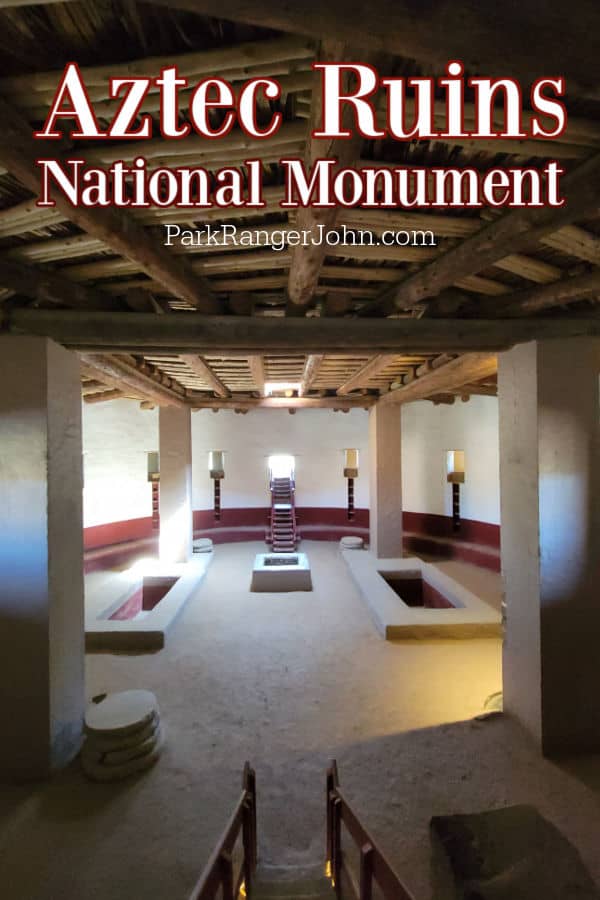
TL;DR Don’t have time to read the full article? Here are my top finds:
🏨Hotels and Vacation Rentals
📍Tours
🐻 Save time! Buy your National Park Pass before your trip
Aztec Ruins National Monument
Aztec Ruins NM offers the opportunity to learn more about ancient Puebloan life. The 400 masonry rooms of the Great House are accessible and can be explored during a visit.
The park gives visitors the opportunity to step back in time and imagine what life was like 900 years ago.
About Aztec Ruins National Monument
This settlement was planned and built by ancestral Puebloans from the late 1000s to the late 1200s. The settlement included large public buildings, smaller structures, earthworks, and ceremonial buildings.
This community rivaled the Chaco Canyon community which is 55 miles south and flourished from 850 to 1130.
The ancestral Pueblo People were influenced by Chacoan architecture, ceramics, and life. It is believed that the ancient people left around the late 1200s.
The Animas River flows from the San Juan Mountains and continues across the plains of northwestern New Mexico. This river provided year-round water.
One thing to remember is the name Aztec does not refer to the people of Mexico but to the Ancestral Puebloan people that lived centuries before the Aztec empire.
Today Aztec Ruins NM is a UNESCO World Heritage Site and preserves and protects the ruins.
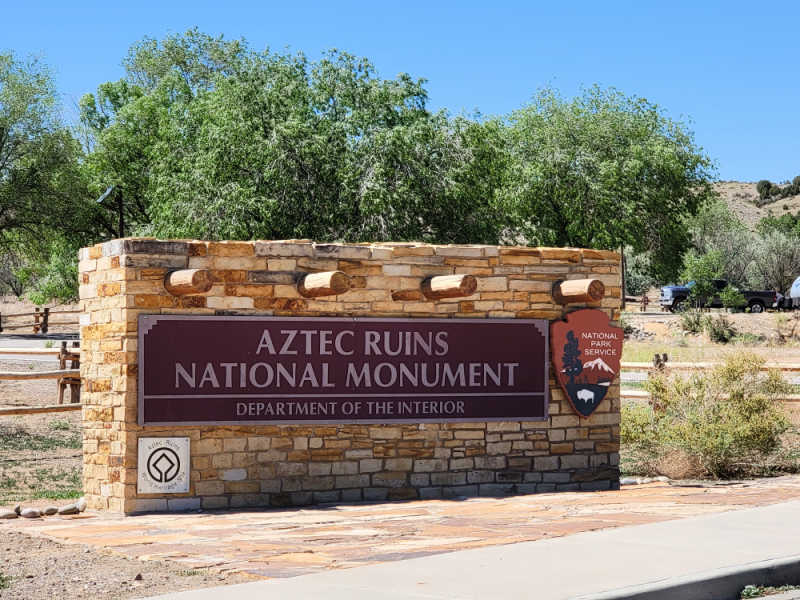
Is Aztec Ruins National Monument worth visiting?
Yes! This is a US National Monument you can easily spend a couple of hours exploring or longer.
We thoroughly enjoyed our visit and would happily return to the park to spend more time exploring.
The Great Kiva is a must visit and hard to describe in writing. We spent 20+ minutes just sitting in the Great Kiva absorbing the energy and feeling within it.
The park was one of our favorites on our Southwest road trip and one we continue to talk about.
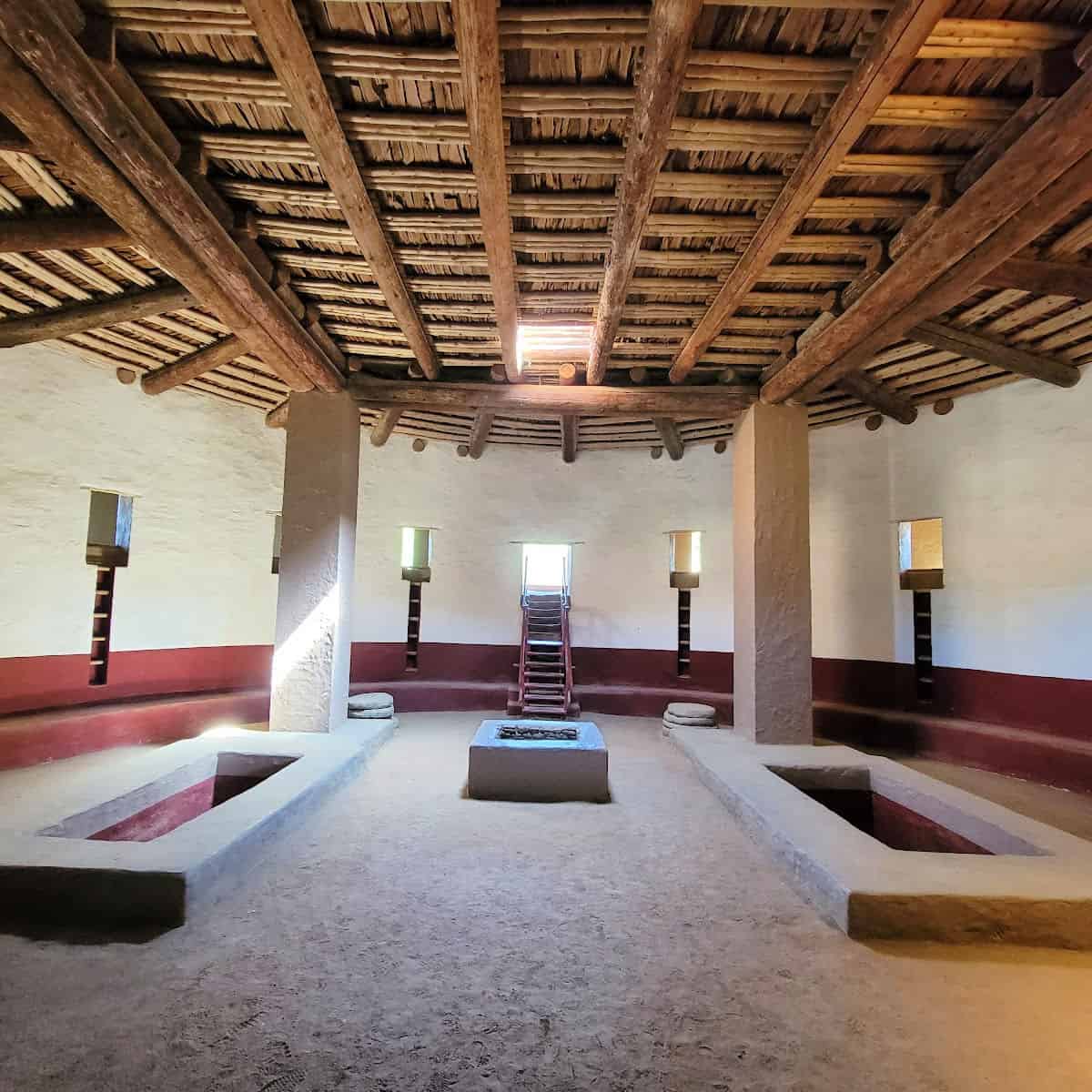
History of Aztec Ruins
Aztec Ruins National Monument is not what it seems. Decades ago travelers in the American Southwest were convinced the ruins within Aztec Ruins National Monument were relics of an Aztec Empire which had once expanded to modern northwest New Mexico.
In fact, the extensive extant structures belong to the Ancestral Puebloans. The national monument’s most prominent feature is its Ancestral Puebloan great houses with hundreds of rooms.
Geology/Geography
Aztec Ruins National monument is located near the Animas River. The Animas River feeds into the San Juan River and later the Colorado River.
Aztec Ruins National Monument is in extreme northwest New Mexico and part of the Four Corners region which includes northeast Arizona, northwest New Mexico, southwest Colorado, and southeast Utah.
The great houses protected within Aztec Ruins National Monument are constructed of a type of sandstone which is common across the Colorado Plateau.
Stones for the great house were chiseled from sandstone formations that were formed millions of years ago by the Western Interior Seaway.
This inland sea experienced expansions and contractions over hundreds of millennia. Changing shorelines pressured layers of sand and minerals into the striated and colorful layers visible within the Animas River Valley walls.
Oxidation of minerals within the sandstone layers created the stone’s vibrant colors.
History
Ancestral Puebloans constructed hundreds of abodes across the Colorado Plateau beginning in the 900s CE.
Alongside Aztec Ruins National Monument, similarly famous architectural sites include Mesa Verde and Pueblo Bonito at Chaco Canyon.
Each of the sites display similar building techniques and materials. Tree-ring dating indicates that the great houses were constructed in the 11th and 12th centuries, centuries after construction began in Mesa Verde and Pueblo Bonito.
The great houses within Aztec National Monument are built from sandstone and timber.
It is believed that some of the ponderosa pine and other timber were hauled to the great houses from the San Juan Mountains.
The distance required for the timber to travel highlights the logistical and technical capabilities of the Ancestral Puebloans.
Archeoastronomy
Aztec Ruins National Monument is a case study in archeoastronomy – the prehistoric practice of aligning buildings and artifacts with celestial bodies.
At Aztec Ruins National Monument, the northern wall of the Aztec West great house is built on a perfect line between the horizon point of the winter solstice sunset and the summer solstice sunrise.
The study of this fascinating connection between Ancestral Puebloan culture and the heavenly bodies is ongoing.
Kivas are circular ceremonial structures used by many Native American groups in the American Southwest. The Great Kiva at Aztec Ruins National Monument has been rebuilt.
The entries and windows into this kiva light up at predictable solar intervals, hinting again at the link between architecture and astronomy.
Americans in “Aztec” Ruins
When the United States took control of the American Southwest following the Mexican-American War (1846-1848), many groups headed West.
Some were appointed by the government to map and explore. Others were in search of riches, adventure, or to escape problems in the east.
Early American settlers encountered the immense great houses scattered across the Colorado Plateau.
These great houses tended to be near waterways which were lifelines to Ancestral Puebloans and to newly arrived Americans.
The land near the Animas River on which the Aztec great houses are located was homesteaded in 1906 by H. D. Abrams. Through the Homestead Act of 1862, Abrams received the 160 acres of land along with what he thought were Aztec ruins.
Abrams protected the ancient landmarks and became a local political leader.
Becoming a Park
Aztec Ruins National Monument became protected by the National Park Service in 1923.
It joined the federal registry of protected places in the same era as a wave of other Chacoan cultural locations such as Mesa Verde and Pueblo Bonito.
The ruins were academically investigated by Earl and Ann Morris who excavated portions of the Aztec East and West great houses. Earl took a leading role in the reconstruction of the Great Kiva in the West great house.
Park boundaries have changed slightly over the years, but the great houses remain the key features of the monument.
Aztec Ruins National Monument is a testament to the engineering prowess of the Ancestral Puebloans.
The ruins represent another example of the incredible abilities to organize, trade, and build according to advanced mathematical and astronomical principles.
The monument’s name, Aztec Ruins, is a signpost indicating the vast growth of our historical understanding of Native Americans’ long habitation of the desert southwest.
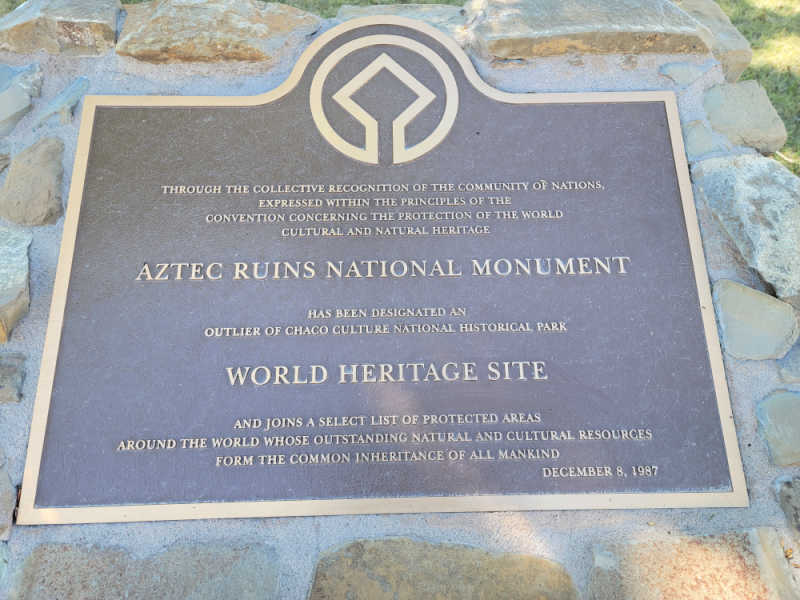
Things to know before your visit to Aztec Ruins National Monument
Entrance fee
$0.00 There is no entrance fee to enter the park.
Learn more about National Park Passes for parks that have an entrance fee.
$80.00 - For the America the Beautiful/National Park Pass. The pass covers entrance fees to all US National Park Sites and over 2,000 Federal Recreation Fee Sites for an entire year and covers everyone in the car for per-vehicle sites and up to 4 adults for per-person sites.

Buy your pass at this link, and REI will donate 10% of pass proceeds to the National Forest Foundation, National Park Foundation, and the U.S. Endowment for Forestry & Communities.
National Park Free Entrance Days -Mark your calendars with the free entrance days the National Park Service offers for US citizens and residents.
Time Zone
MST - Mountain Standard Time
Pets
Pets are allowed in the picnic area as long as they are on a leash 6 feet or less.
Pets are not allowed in the visitor center or near the ruins.
Cell Service
Cellphone reception is good on a variety of carriers.
Park Hours
The monument and the Visitor Center are both open every day from 9 am-5 pm.
The monument and Visitor Center will be closed on Thanksgiving, Christmas, and New Year's Days.
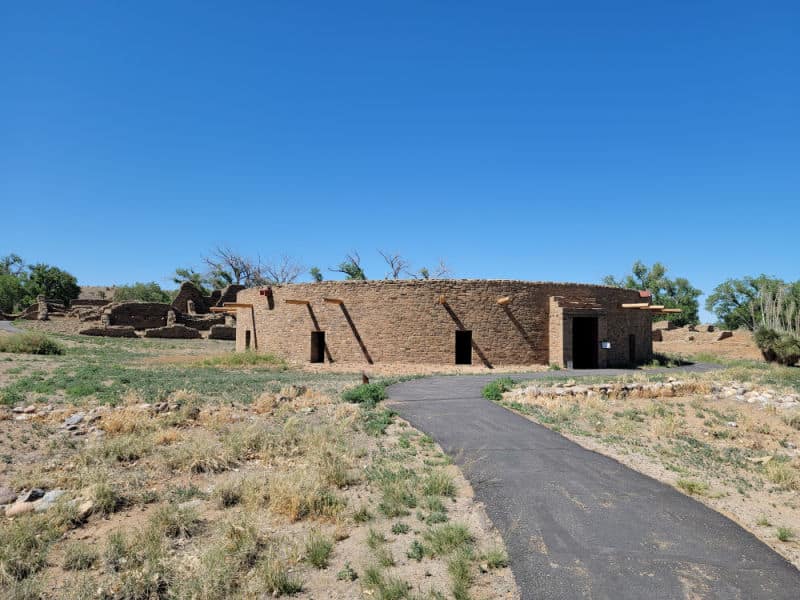
Wi-Fi
There is no public access to Wi-Fi within the monument. The closest public Wi-Fi options are located within the adjacent city of Aztec, NM.
Insect Repellent
Insect repellent is always a great idea when outdoors, especially if you are around any body of water.
We use Permethrin Spray on our clothes before our park trips.
Water Bottle
Make sure to bring your own water bottle and plenty of water with you. Plastic water bottles are not sold in the park.
Parking
There is a nice size parking lot right in front of the visitor center.
Food/Restaurants
There are no restaurants in the park. There are multiple just down the street.
The park has a fantastic picnic area perfect for enjoying lunch while visiting the park.
The picnic shelters are in the shade of cottonwood trees and have views of the heritage garden and the great kiva.
Gas
There are no gas stations within the park.
Drones
Drones are not permitted within National Park Sites.
National Park Passport Stamps
National Park Passport stamps can be found in the visitor center.
The park is featured as part of the 2005 Passport Stamp Set.
We like to use these circle stickers for park stamps so we don't have to bring our passport book with us on every trip.
The National Park Passport Book program is a great way to document all of the parks you have visitied.
You can get Passport Stickers and Annual Stamp Sets to help enhance your Passport Book.
Electric Vehicle Charging
There is 1 charging station in Aztec, New Mexico
There are 26 public charging stations in Farmington, New Mexico.
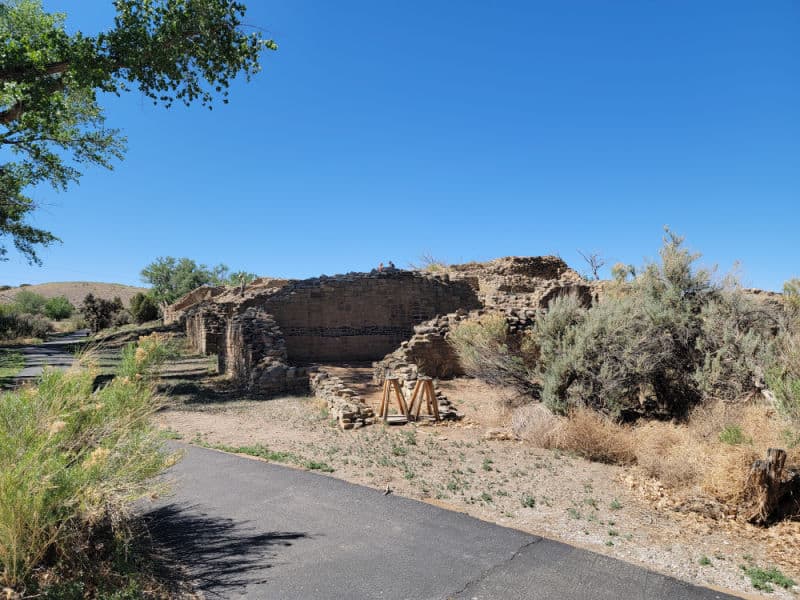
Details about Aztec Ruins National Monument
Size - 318 acres
Check out how the park compares to other National Parks by Size.
Date Established
January 24, 1923 the area was designated a National Monument by President Warren G. Harding.
December 8, 1987 listed as a UNESCO World Heritage Site along with Chaco Culture NHP
Aztec Ruins NM Address
725 Ruins Road
Aztec, NM 87410
United States
Aztec Ruins National Monument Map
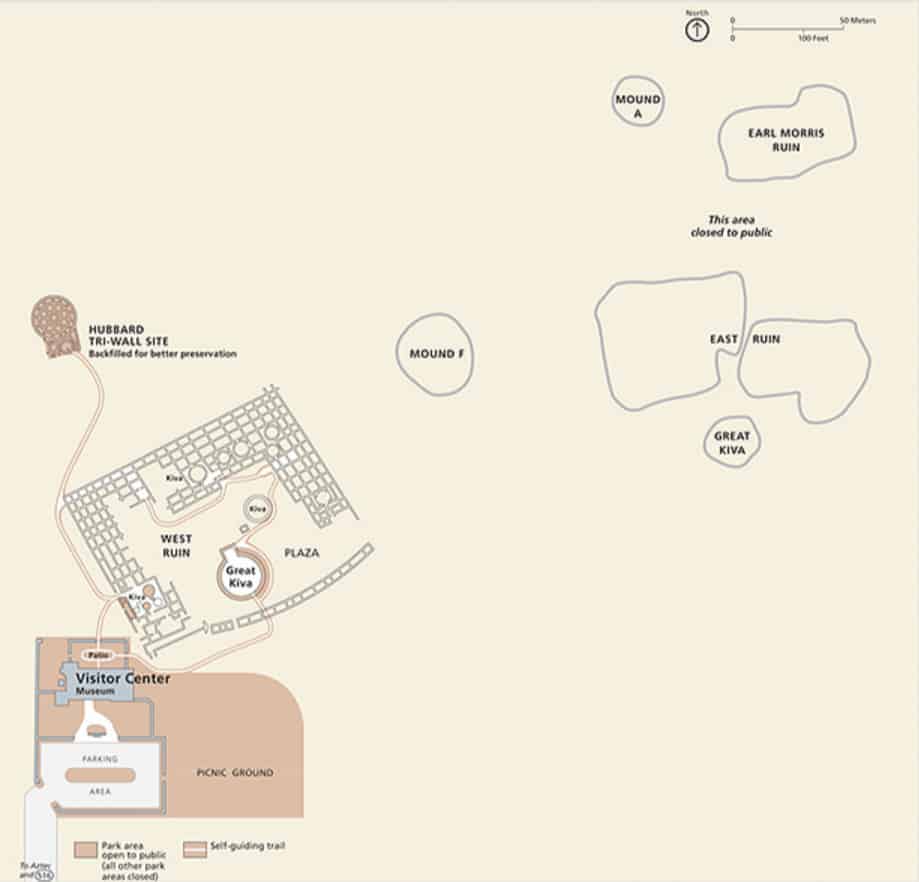
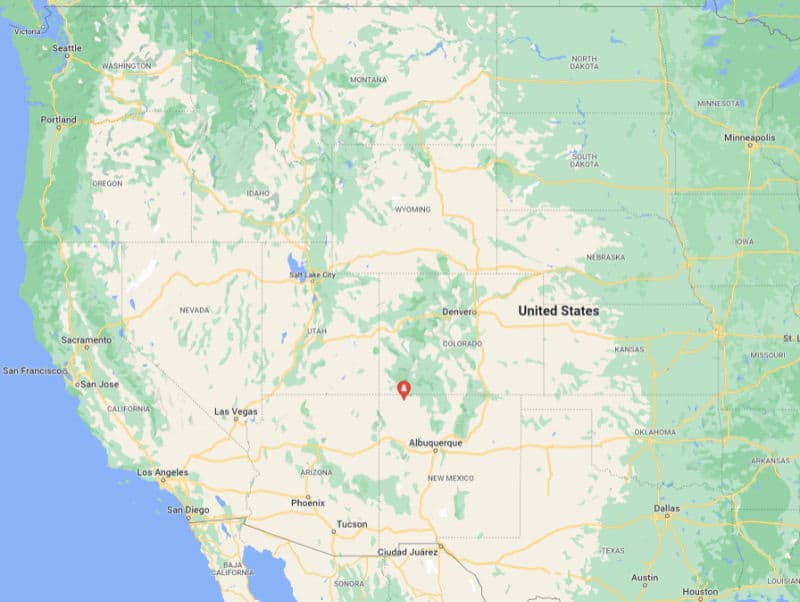
Where is Aztec Ruins NM?
Aztec Ruins NM is located in Northwestern New Mexico approximately 15 miles from the border of Colorado. The closest towns are Aztec and Farmington, New Mexico
Estimated distance from major cities nearby
- Farmington, NM - 14 miles
- Durango, CO - 36 miles
- Albuquerque, NM - 141 miles
- Colorado Springs, CO - 224 miles
- Denver, CO - 261 miles
- Scottsdale, AZ - 317 miles
- Phoenix, AZ - 325 miles
- Tucson, AZ - 358 miles
Estimated Distance from nearby National Park
Mesa Verde National Park - 67 miles
Black Canyon of the Gunnison National Park - 154 miles
Great Sand Dunes National Park - 191 miles
Arches National Park - 195 miles
Petrified Forest National Park - 196 miles
Grand Canyon National Park (South Rim) - 294 miles
Where is the National Park Visitor Center?
The visitor center is located at the main entrance to the park.
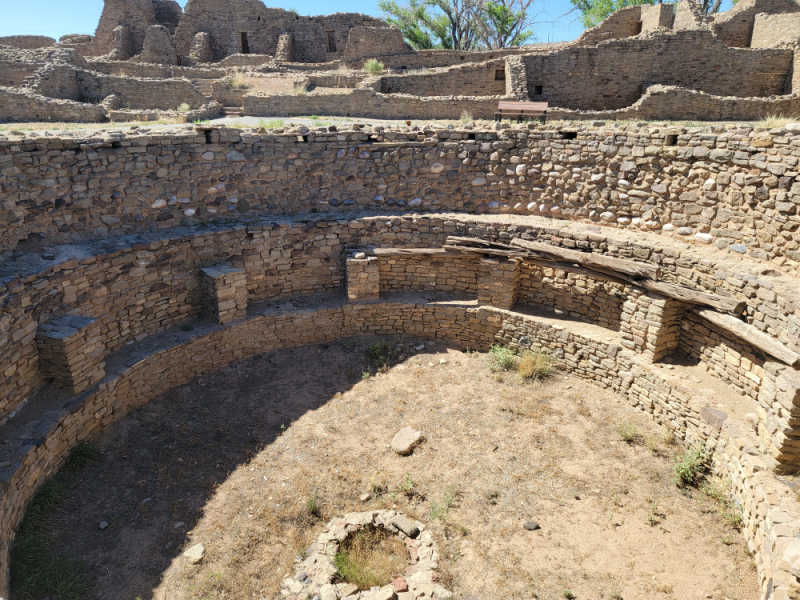
Getting to Aztec Ruins National Monument
Closest Airports
- Four Corners Regional Airport (FMN) - 18 miles
International Airports
- Albuquerque International Sunport (ABQ) - 182 miles
Regional Airports
- Durango-La Plata County Airport (DRO) - 37 miles
- Cortez Municipal Airport (CEZ) - 85 miles
- Montrose Regional Airport (MTJ) - 147 miles
- Los Alamos County Airport (LAM) - 166 miles
Driving Directions
Aztec Ruins NM is located on Ruins Road about ½ mile north of New Mexico Highway 516 in the city of Aztec, New Mexico.
From Albuquerque/Bloomfield, NM
Follow Highway 550 north into the City of Aztec, turn left at the “T” intersection onto Highway 516, drive ¾ mile, then turn right immediately after crossing the river onto Ruins Road.
Follow Ruins Road ½ mile to the monument.
From Durango, CO
Follow Highway 550 south into the City of Aztec. Highway 550 will become 516. Follow 516 and turn right immediately after crossing the river onto Ruins Road.
Follow Ruins Road ½ mile to the monument.
From Farmington, NM
Follow Highway 516 east into the City of Aztec. ¼ mile past Lightplant Road, turn left onto Ruins Road.
Follow Ruins Road ½ mile to the monument.
Public Transportation - Bus
From Farmington, take the Aztec Tiger Bus Route on the Red Apple Transit to the Safeway/W Express stop.
Walk north on Main Street, crossing Highway 516, and walk along the Old Spanish Trail across the footbridge to Aztec Ruins National Monument.
It is approximately a 20 minute walk from the bus stop to the monument.
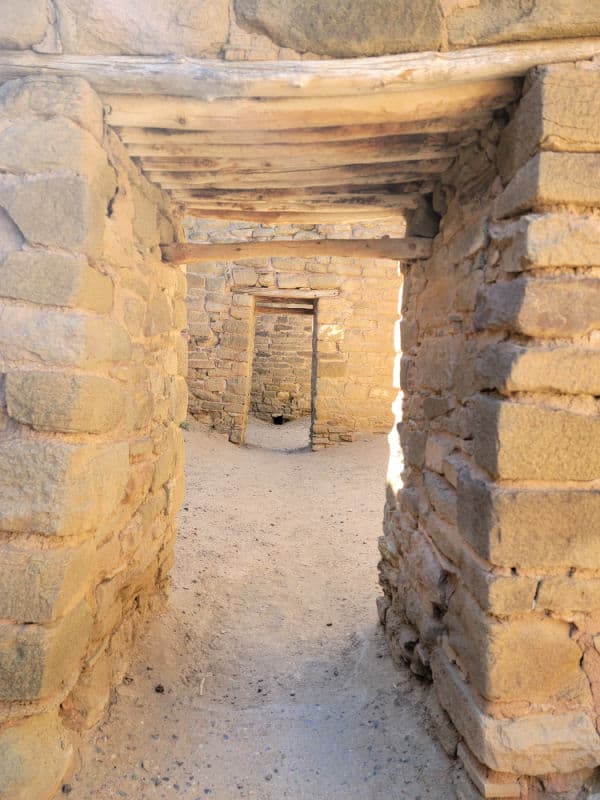
Best time to visit Aztec Ruins National Monument
The best time to visit Aztec Ruins is in the Fall when the weather is cooler and comfortable.
That being said it is an epic park to visit year-round if you are in the area.
Weather and Seasons
Aztec, New Mexico experiences hot dry summers and very cold snowy winters.
The hottest time of year is from May 29 to September 15th when the average daily temperature exceeds 80°F.
The coldest time of year is from November 23 to February 21 when the average daily temperature is below 49°F.
One thing to know is the wet weather season lasts for 7.9 months in Aztec, New Mexico from July 8 to March 3rd. There is a greater than 14% of rain during this time.
The most rain occurs in August with an average of 6.8 days of some rain.
Snow occurs from December 4 to February 28th with January getting the most snow on average of 2 inches.
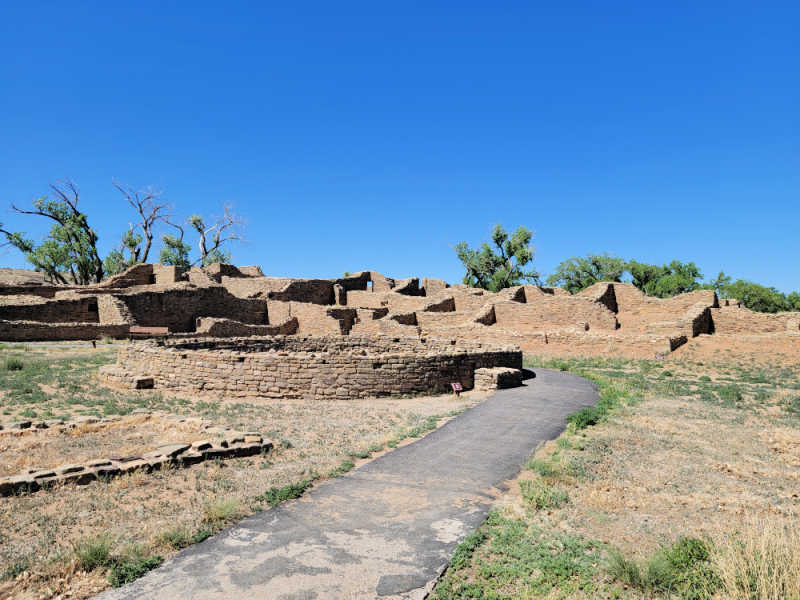
Best Things to do in Aztec Ruins National Monument
The best things to do in Aztec Ruins NM is to plan time to explore the self guided trail that leads you through/past the 400 masonry rooms of the Ancestral Pueblo Great House and the largest reconstructed great Kiva.
While exploring the park look for fingerprints of ancient workers in the mortar of the buildings.
Visitor Center
At the visitor center you can watch the park movie - Aztec Ruins: Footprints of the Past, view ancient pottery and weavings, see an original ladder from the site.
There is a park bookstore with great books and souvenirs for the park. The visitor center started as the home of pioneering archeologist Earl Morris. You will see the visitor center called "Earl's House".
Don't miss the heritage garden filled with native plants as you walk towards the self-guiding trail.
Cell Phone Tour
There is a great self-guided audio tour of the park available. Each of the stops is numbered and you can listen in whatever order works best for you.
There are 18 trail stops along the tour plus you can listen to cultural history on the audio tour.
Junior Ranger Program
The park's Junior Ranger program is super cool! You can earn a badge online or while you are in the park. Check out the online program here.
You can also pick up a program while visiting the park and talk with a ranger to earn a badge.
The Great Kiva
The reconstructed Great Kiva is a semi-subterranean structure that was used long ago as a ritual and social community gathering place. It was a sanctuary for the people who lived here.
Today it is a place of wonder and awe! I had to sit for a while in the Great Kiva just to take it all in. There was so much peace and tranquility just sitting in the quiet listening to the wind.
I highly suggest planning time during your visit to just sit and absorb the atmosphere of the Great Kiva.
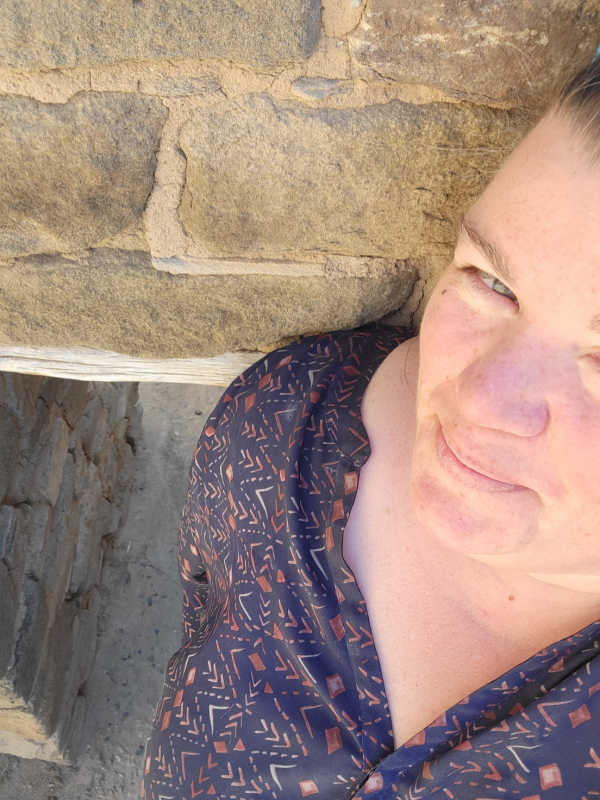
The West Ruin Trail
The West Ruin Trail travels 800 yards through a massive "great house" that was built in the early 12th Century. The West Ruin stands three stories tall and is wider than a football field across the back.
The large structure now known as Aztec West had over 400 rooms and many kivas.
You can explore dark chambers that were roofed with timbers cut over 900 years ago. There are trail guides available at the visitor center.
One thing to know about entering the "Great House" is there are many low entrance ways. When I say low I mean super low your knees are going to ache trying to get through them low!
If you have any mobility restrictions, knee or joint problems, or aches and pains I highly suggest being really careful about which entranceways you attempt. You can see a lot of the site without having to crawl down low.
My wife Tammilee is about 5 foot 5 inches and the doorway did not even reach her shoulders in one area. This was not the lowest doorway we found in the Great House.
Old Spanish National Historic Trail
The Old Spanish National Historic Trail was the first recorded trade caravan from Santa Fe, NM all the way to Los Angeles, CA.
You can follow the nationally designated trail from the picnic area, over the bridge across the Animas River, and into historic downtown Aztec.
Picnic area to the Animas River- ½ mile
Picnic area to historic downtown Aztec- 1 ½ miles
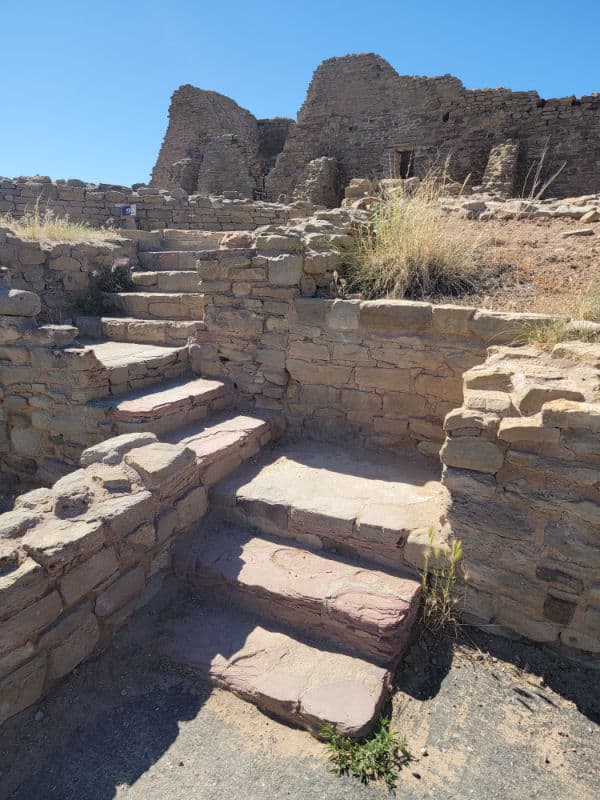
Interpretive Programs/Special Events
From May through September Rangers offer interpretive talks and guided tours at scheduled times.
During the summer there are also evening lecture series that cover/demonstrate traditional American Indian arts and astronomy.
Special Events include full moon walks and special Junior Ranger programs.
Wildlife/Bird Watching
One of the really nice surprises for us during our visit was the number of birds we saw in the park.
There are 70 bird species that have been documented in the park along with 28 mammal species, 3 amphibians, and 10 reptiles.
Camera Gear we use
We are big fans of using great camera gear to get amazing photos while traveling.
Canon R5 - We recently upgraded to the R5 after using a Mark 5 for years. We are loving the camera shutter speed and quality of images.
Canon 100 - 500mm - We use the Canon 100-500 for wildlife photography.
Camera Rain Cover - A rain cover will help protect your camera during rain showers but also when photographing waterfalls.
Camera Cleaning Kit - Cameras can get dirty, beat up, and dusty while in the parks. We like having a cleaning kit with us so we can do on the spot touch ups.
Extra Camera Batteries - We suggest always having one or two extra camera batteries with you. There is nothing worse than going to take a shot and the battery dies.
Extra Memory Cards - We use Extreme PRO SanDisk cards
Heritage Garden and Native Plants Walk
Near the entrance to the picnic area you will find the Heritage Garden and Native Plants Walk.
Traditional crops are planted here including corn, beans, squash, sunflowers, and gourds. The garden is maintained by park staff and volunteers.
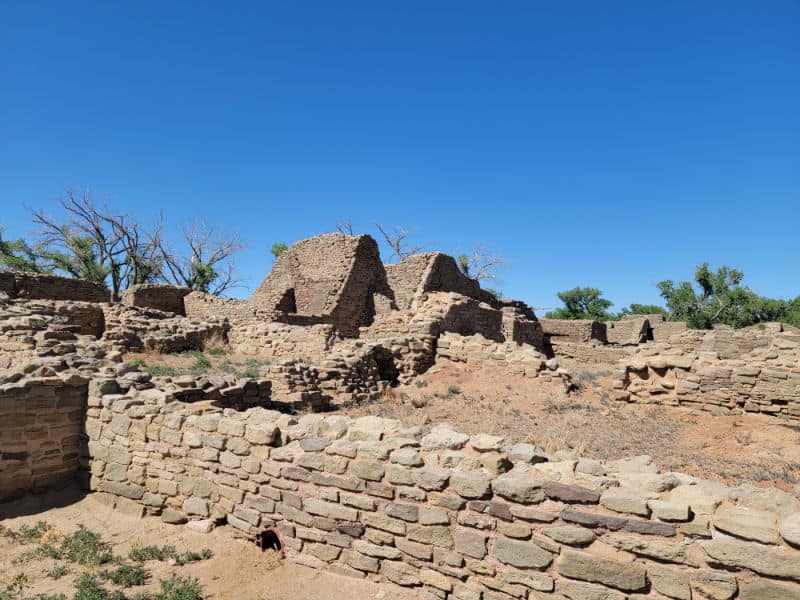
Hiking in Aztec Ruins National Monument
Always carry the10 essentials for outdoor survival when exploring.
Walking the self guided loop is the only "hike" within the park. That being said we do suggest making sure you are prepared for the bright sun, weather, and uneven steps within the monument.
How to beat the crowds in Aztec Ruins National Monument?
We did not experience any crowds while visiting the park. There were other visitors but the park had more than enough room to feel like we were experiencing it on our own.
We sat in the Great Kiva for 20+ minutes and saw only a couple of other visitors.
Where to stay when visiting Aztec Ruins National Monument
There are no National Park Lodges within the campground.
TownePlace Suites by Marriott Farmington - 9 miles from the park.
We stayed at this Townplace Suites and it worked great. Free continental breakfast, dry cleaning/laundry services, and a 24-hour gym at TownePlace Suites by Marriott Farmington. In addition to a 24-hour business center, guests can connect to free in-room Wi-Fi.
Comfort Inn & Suites - 2 miles from park
Free to-go breakfast, 18 holes of golf, and an outdoor public bath (no minerals) are just a few of the amenities provided at Comfort Inn & Suites. In addition to a free grocery shopping service and a terrace, guests can connect to free in-room Wi-Fi.
Best Western Territorial Inn & Suites - 8 miles from the park
Free full breakfast, laundry facilities, and a gym. For some rest and relaxation, visit the hot tub. Free in-room WiFi and a 24-hour business center are available to all guests.
Home2 Suites by Hilton - 11.6 miles from the park
Free continental breakfast, dry cleaning/laundry services, and a gym are just a few of the amenities provided at Home2 Suites by Hilton Farmington/Bloomfield. In addition to a business center and a snack bar/deli, guests can connect to free in-room Wi-Fi.
Click on the map below to see current rates for hotels and vacation rentals near Aztec, New Mexico
Camping
There isn't a National Park managed campground within the park.
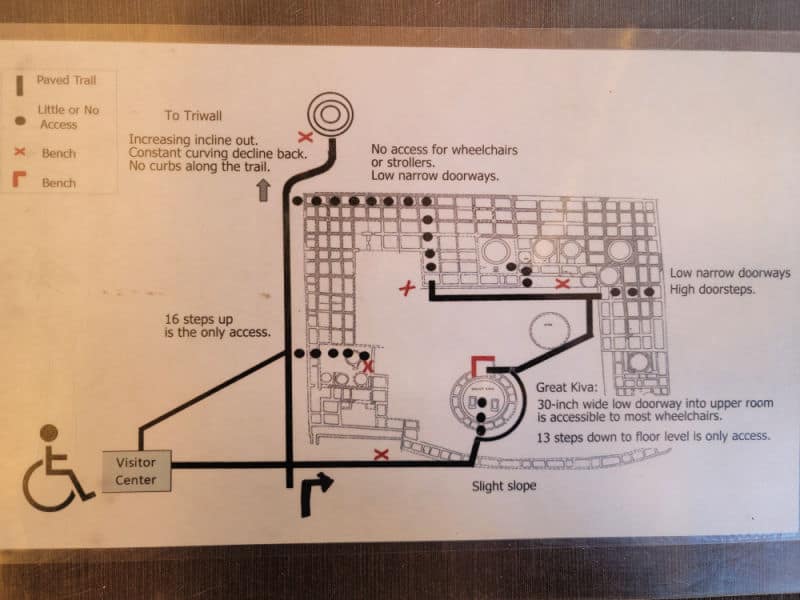
Accessibility
The visitor center, restrooms, picnic area, and a large portion of the self-guided trail are wheelchair accessible.
The park has a map showing accessible paths through the self-guided trail. Access to the Great Kiva is available for most wheelchairs 29" of less into the antechamber.
For sight impaired visitors the visitor center has a tactile model of the West Ruins and replica artifacts. Large print trail guides are also available.
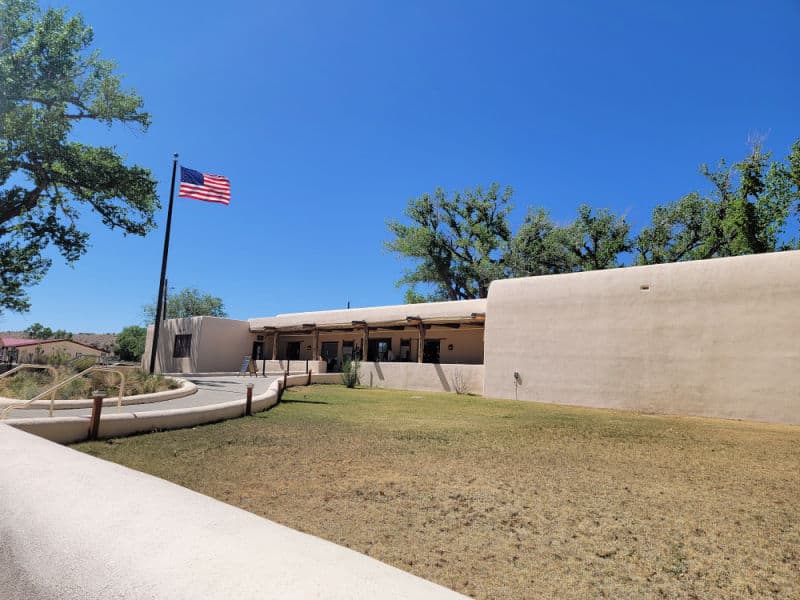
Parks Near Aztec Ruins NM
Chaco Culture National Historical Park - 70 miles
Hovenweep National Monument - 111 miles
Valles Caldera National Preserve - 148 miles
Canyon De Chelly National Monument - 166 miles
Hubbell Trading Post National Historic Site - 166 miles
Monument Valley - 174 miles
Navajo National Monument - 180 miles
Bandelier National Monument - 227 miles
Pecos National Historical Park - 230 miles
Check out all of the New Mexico National Parks along with neighboring Arizona National Parks, Colorado National Parks, National Parks in Oklahoma, National Parks in Utah, and National Parks in Texas
National Park Service Website - https://www.nps.gov/azru/index.htm
Make sure to follow Park Ranger John on Facebook, Instagram, Pinterest, and TikTok

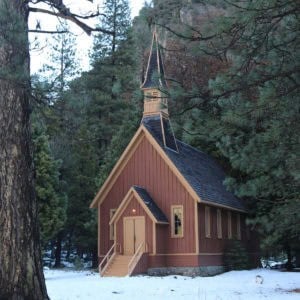
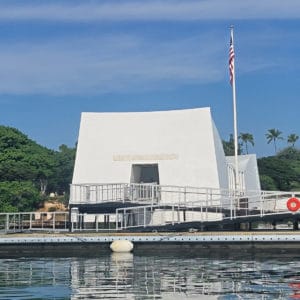
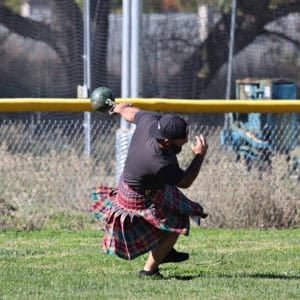

Leave a Reply